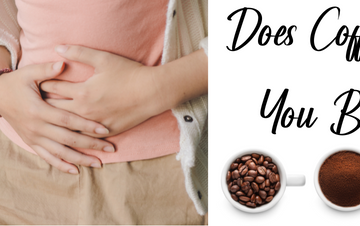What is decaf coffee and is it good or bad for you

I have prepared this article for those of you who need to reduce your caffeine intake and want to find an answer to the question “What is decaf coffee.”
If you are a frequent visitor to Starbucks, you could find some very good offers of decaffeinated coffees.
In this article, you will see a comparison between decaffeinated coffee and a regular one. You will find out if the decaf coffee is with less acidity or not.
I am also covering the production process of decaffeinated coffee and what positive and negative effects this leads to.
In some places, I have prepared tables for you so that all the information is more structured.
Enjoy reading.
TABLE OF CONTENTS:
- What is decaf Coffee?
- Pros of Drinking Decaf Coffee
- Cons of Drinking Decaf Coffee
- How is Decaf Coffee made?
- How much Caffeine in Decaf Coffee?
- What are the Differences between Decaf and Regular Coffee?
- F.A.Q.
What Is Decaf Coffee?
Studies show that decaf refers to decaffeinated coffee; however, it is not caffeine-free. It is coffee with at least 97% of the caffeine extracted from the beans.
To put this into perspective, a decaffeinated 12-ounce (354-ml) cup of coffee with 180 mg of caffeine would contain around 5.4 mg of caffeine.
The amount of caffeine in Starbucks decaf iced coffee varies depending on the bean and the decaffeination method used.
Overall, the type of roasted coffee you buy has a more significant impact on the flavor than the technique of decaffeination. On the other hand, the decaffeination procedure changes the smell and taste of coffee. It gives it a softer flavor and a different color.
Pros of Drinking Decaf Coffee
Drinking decaffeinated coffee can help you if you have trouble taking high amounts of caffeine. This way, you will both admire the taste and aroma of freshly brewed coffee, and your cup will contain minimal amounts of caffeine.
Some of the problems that decaf coffee solve are:
Caffeine sensitivity
It is a condition in which a person is sensitive to caffeine. You may avoid the detrimental effects of caffeine in regular coffee by drinking decaf coffee. Caffeine in coffee causes sleeplessness, restlessness, heart palpitations, elevated blood pressure, glucose intolerance, and anxiety in many people.
Caffeine-related health issues
Caffeine is also a stimulant and a diuretic, and an acidic substance. Suppose you have heartburn, gastrointestinal difficulties, or trouble sleeping. In that case, decaf iced coffee Starbucks can help you avoid the adverse effects of caffeine while still allowing you to drink coffee.
Anxiety caused by caffeine
Anxiety is a typical coffee adverse effect. Caffeine can cause jitters, a state of restlessness, and anxiousness. However, it’s crucial to remember that while coffee does not cause anxiety, it can exacerbate symptoms in those already anxious. Suppose you suffer from anxiety and consume regular coffee. In that case, you might want to consider switching to decaf coffee if you discover that it worsens your anxiety.
Problems with digestion and dehydration
According to a study, coffee causes reflux and a gastrocolic reaction in some persons after drinking it. That suggests some laxative effects, although this is still under investigation today. Finally, everyone’s physique is unique. You should know that you are the most excellent judge of yourself.
Cons of Drinking Decaf Coffee
Why decaf coffee is bad for you?
Decaffeinated coffee might also include the following ingredients that may have a negative influence on our bodies:
Chemicals
Some decaf coffee contains methyl chloride, a chemical found in paint remover. In humans, excessive doses of this chemical can cause severe neurological consequences. In animals, continuous exposure can cause central nervous system effects. While minor levels of this chemical are harmless, be sure to read the labels if you want to avoid it entirely. Decaf coffee that does not specify decaffeinated is usually made with methyl chloride.
Cholesterol
Many research studies have analyzed the effects of decaf coffee on cholesterol in humans. Some suggest that it raises cholesterol levels, while others maintain no impact. For the time being, the data are ambiguous. Still, if you are concerned about your cholesterol levels, you should consult your doctor.
Teeth might show signs of damage
A study shows that coffee consumption can have an anti-caries effect on teeth. They also found that if there are any additives, the anti-caries and antibacterial action are minimized.
Also, the fact that decaffeinated coffee contains acids should not be overlooked. Acids weaken the tooth enamel and yellowish discoloration.
Prevention of these negative effects can be achieved through drinking water and brushing teeth after drinking coffee.
How Decaf Coffee Is Made?
There are many ways to make decaf. For example, you can fill the green coffee beans with water. After that, remove the caffeine with solvents, like carbon dioxide or water.
There are four methods for decaffeinating coffee that are now accessible. There are two types of strategies: solvent-based and non-solvent-based. Direct-solvent and indirect-solvent procedures are two types of solvent-based processes.
Non-solvent-based procedures include the Swiss water technique and the carbon dioxide process. I’ll take a quick look at how each method works, emphasizing the Swiss water process, the most common way.
Solvent-Based Decaffeination Process
There must be a decaffeination agent for decaffeination to occur. In this situation, we use a solvent to extract the caffeine from the coffee beans, either directly or indirectly. This is the approach that Ludwig Roselius initially utilized. His preferred solvent was benzene, which was no longer practical due to health concerns. Other hazardous solvents, such as trichloroethylene and even chloroform, have also been utilized.
Methylene chloride is the solvent of choice nowadays. When people make coffee, they usually make one part per million. The amount of caffeine in the decaffeination process is less than the FDA’s limit of ten parts per million. The roasting procedure removes any leftover methylene chloride. That makes it a very safe method for a solvent-based decaffeination process.
Ethyl Acetate Decaffeination
When people use chemicals, they often use ethyl acetate. It is more natural because we can find small amounts of it in fruits and vegetables. Directly or indirectly, solvent-based processes can be carried out.
Coffee beans are first steeped for three to four hours in near-boiling water in an indirect solvent-based approach. This process extracts caffeine, flavor, and oils from the beans. It then moves to a new tank. After that, we clean the beans with methylene chloride or ethyl acetate. These compounds bind to caffeine molecules, subsequently heated to evaporate the caffeine. It all comes to an end when the beans are put back into the caffeine-free liquid. There, they can get back their original tastes and oils again.
Direct solvent-based procedures are what exactly they sound like. People use methylene chloride or alcohol to wash beans right away after they’ve been mildly steaming them. They then let the beans sit in the water for about 10 hours. It’s at this point that the solvent is out of the system. As a result, the beans go through another steaming round to eliminate any remaining chemicals.
The “KVW Method,” “European Preparation,” and “Methylene Chloride” are all common names for this procedure in Europe. Brewers are increasingly using carbon dioxide as a decaffeination process instead of solvents.
Carbon Dioxide Decaffeination
It’s also known as Supercritical Carbon Dioxide Technology. It’s a relatively new decaffeination method. It employs a liquid form of carbon dioxide instead of chemical solvents like methylene chloride. This carbon dioxide can target and eliminate caffeine specifically.
After soaking in water, we place the beans in an extraction stainless steel vessel. We then block up their container with liquid carbon dioxide at 1,000 pounds per square inch and pressurize it. In this case, liquid carbon dioxide behaves similarly to methylene chloride or ethyl acetate. The caffeine is then moved to the absorption chamber, where pressure is released. Carbon dioxide returns to a gaseous form. It is possible to pump this back into a pressurized container and re-use it once more.
People who buy a lot of coffee at the grocery store often choose this method because it’s cheap and easy to do. On the other hand, the Swiss Water Process is the most popular approach since it is chemical-free.
Swiss Water Decaffeination Process
Its name comes from the fact that it was initially developed in Switzerland in the 1930s, albeit it was not commercially successful until 1980. The Swiss Water Process uses osmosis and solubility. That is essential to decaffeinate coffee beans instead of infusing chemicals or solvents directly or indirectly.
Then we steep the beans in boiling water to dissolve the caffeine. This water is drained and run through an activated charcoal filter. The last one is designed to collect more giant caffeine molecules while allowing taste and oil molecules to pass through.
You may imagine that the water would be added to the beans in the following phase to restore taste, but that is not the case: a new batch of beans is brought in. Finally, the beans are put in the water, and they go through the same process.
The water can no longer take the taste and oils from the fresh beans since it already has extracted flavors, so it simply absorbs the caffeine. Next, the decaffeinated beans are filtered out using the same filter with their taste and oils.
It’s worth mentioning that any coffee decaffeinated this way is referred to as “SWISS WATER.” Because this procedure is a little more expensive, it is virtually solely used to decaffeinate 100 percent organic coffee beans. It also undergoes frequent caffeine level assessments to guarantee that it complies with the European Union’s criteria of being 99.9% caffeine-free.
How much Caffeine in Decaf Coffee?
Decaf coffee, despite its name, still contains caffeine.
A standard 8 ounce (oz) cup of decaf coffee has 2 milligrams (mg) of caffeine, according to the United States Department of Agriculture (USDA). Caffeine concentration varies by brand, with some decaf coffees carrying up to 15 mg of caffeine per 8-ounce cup.
Although decaf coffee does not contain zero caffeine, it does have a lower caffeine content than regular coffee. According to the FDA, an 8 oz cup of ordinary coffee generally contains 80–100 mg caffeine.
Green and black teas have a higher caffeine content than decaf coffee. The caffeine content in an 8 oz cup of green or black tea is typically 30–50 mg.
What are the Differences between Decaf and Regular Coffee?
Most of the compounds found in regular coffee are also found in decaffeinated coffee. Due to the caffeine extraction process, decaffeinated coffee has lower values in some compounds.
I have prepared a comparison table between the two coffees. I will be extremely grateful if you can join and complete it 🙂
| Regular Coffee (per 8oz cup) | Decaf Coffee (per 8oz cup) | |
| Caffeine | 80-100mg | 2 – 15mg |
| Antioxidants | Yes | Yes (15% less) |
| Acidity | Less Acidic | More Acidic |
| Side Effects | – Caffeine sensitivity – Stimulant and a diuretic – Acidic substance – Anxiety – Digestion and Dehydration – Restlessness – Palpitations | – Increased bad cholesterol – Higher acidity levels – Contains methyl chloride |
| Benefits | – improve mood, memory, reaction time, and mental function – Increase metabolism – Increase fat burning – Reduced risks of mild depression – Lower risks of liver cirrhosis | Reduces the Risks of: – Type 2 Diabetes, – Liver Function, – Premature Death – Aging -Neurodegenerative Diseases |
| Taste | Strong Bitter | Flat Watery |
F.A.Q.
Is Decaf Coffee More Acidic than Regular Coffee?
Some studies give a more in-depth understanding of the differences between Arabica and Robusta coffee beans.
| Arabica | Robusta | |
| Carbohydrates | 34 to 44% | 48–55% |
| Lipid content | 15–17% | 7–10% |
| Sucrose content | 6.25 to 8.45% | 0.9% to 4.85% / 4.05–7.05% |
| Caffeine content | 0.90–1.3% | 1.51 to 3.33% |
| Trigonelline | < 0.75 to 1.24% | 0.75 to 1.24% |
| Chlorogenic acids (CGAs) | 70 and 200 mg | 70 and 300 mg |
Decaf coffee has less acidity than standard coffee because of the type of beans used for the decaffeination process, which is Robusta.
Robusta beans contain a higher caffeine concentration and have higher levels of acidity in comparison to other varieties of beans. The interesting fact here is that the pH increases with the roasting process.
Acidity is measured with Ph levels. Ph levels 7 or above indicate lower acidity levels, while less than 7 indicate more acidity. If the acidity level is 7 is neutral.
Decaf coffee is measured at 5.0 or 5.1 Ph levels. However, regular coffee made from Robusta beans is around 5.0 Ph, while Arabica beans are even less.
Does Decaf Coffee Have Higher Antioxidants Than Regular Coffee?
There aren’t any significant differences in terms of antioxidants between decaf and regular coffee. Coffee, whether it is caffeine-free or not is full of active biological elements.
It is important to say that the amount of antioxidants in various types of coffee vary by 1.5 times, at the most. This is due to the origin country, the roasting degree, the coffee, the method of processing it, and the altitude at which the coffee was harvested as well as the soil type, average temperature, as well as the amount of days with sunshine throughout the year.
Polyphenols and Hydro Cinnamic Acids are two of the most important antioxidants in coffees of both kinds. They play a role in reducing the risk of heart disease as well as Type 2 diabetes.
Another antioxidant is Ferulic acid is involved in preventing oxidative damage to our bodies and aids in reducing inflammation of the brain. In simple terms, this is the reason for the reduction in risk of developing Alzheimer’s or Parkinson’s Disease.
However, when it comes to antioxidant content, decaf has 15% less antioxidants than normal coffee. This is because certain elements are removed when decaffeination is done.
Does Decaf Have Caffeine?
Extraction of caffeine in the decaffeinated process decreased the amount of phenolic acids, in addition to the antioxidant capacity. Nevertheless, this process can not fully extract caffeine.
Thus, decaffeinated coffee contains around 15mg per 8 ounces cup.
Is decaf coffee as healthy as regular coffee?
Decaffeinated coffee contains the same substances that are beneficial to the human body as regular coffee. After the decaffeinated process slightly, some of these compounds are with lower levels.
However, the use of chemicals in the production of decaffeinated coffee (extracting caffeine from it) remains traces of methylene chloride. Its use can cause headache, lightheadedness, irritability, drowsiness, coughing, or wheezing.
To obtain these adverse effects, a dose of about 200 parts per million (ppm) should be taken. According to the FDA, decaffeinated coffee contains about 10 ppm, which makes this coffee harmless.
Is Decaf Coffee Safe for Pregnant Women?
It’s clear that caffeine, particularly normal coffee is a huge no-no in the lives of pregnant women. Based on the American Pregnancy Association, caffeine decreases the fertility of animals which is why it’s best to cut down the caffeine intake. Some studies show that a daily dose of around 200mg can lead to miscarriage. Other studies show that caffeine amounts between 200-350mg per day are no risk for pregnant women.
Because of this conflict in conclusions, the Association stated that pregnant women should limit their caffeine to less than 200mg per day.
It should also be remembered that many other foods and beverages contain caffeine.
So, if you are pregnant, it is better to consult with a doctor.
Is it OK to drink a lot of decaf coffee?
Decaffeinated coffee is harmless if not consumed in excessive doses like everything else. On the one hand, it contains acids, and on the other hand, the presence of methylene chloride is observed. Acids can damage both tooth enamel and the stomach. Methylene chloride is dangerous if the dose of 200ppm is exceeded. For comparison, a cup of decaffeinated coffee contains around 10ppm.
References
- McCusker RR, Fuehrlein B, Goldberger BA, Gold MS, Cone EJ. Caffeine content of decaffeinated coffee. J Anal Toxicol. 2006 Oct;30(8):611-3. https://doi.org/10.1093/jat/30.8.611. PMID: 17132260.
- van Dusseldorp M, Smits P, Thien T, Katan MB. Effect of decaffeinated versus regular coffee on blood pressure. A 12-week, double-blind trial. Hypertension. 1989 Nov;14(5):563-9. https://doi.org/10.1161/01.hyp.14.5.563. PMID: 2680964.
- Silvarolla MB, Mazzafera P, Fazuoli LC. Plant biochemistry: a naturally decaffeinated arabica coffee. Nature. 2004 Jun 24;429(6994):826. https://doi.org/10.1038/429826a. PMID: 15215853.
- Chen Y, Brown PH, Hu K, Black RM, Prior RL, Ou B, Chu YF. Supercritical CO2 decaffeination of unroasted coffee beans produces melanoidins with distinct NF-κB inhibitory activity. J Food Sci. 2011 Sep;76(7):H182-6. https://doi.org/10.1111/j.1750-3841.2011.02304.x. Epub 2011 Aug 8. PMID: 21824138.
- Wendl B, Pfeiffer A, Pehl C, Schmidt T, Kaess H. Effect of decaffeination of coffee or tea on gastro-oesophageal reflux. Aliment Pharmacol Ther. 1994 Jun;8(3):283-7. https://doi.org/10.1111/j.1365-2036.1994.tb00289.x. PMID: 7918922.
- Reis JP, Loria CM, Steffen LM, Zhou X, van Horn L, Siscovick DS, Jacobs DR Jr, Carr JJ. Coffee, decaffeinated coffee, caffeine, and tea consumption in young adulthood and atherosclerosis later in life: the CARDIA study. Arterioscler Thromb Vasc Biol. 2010 Oct;30(10):2059-66. https://doi.org/10.1161/ATVBAHA.110.208280. Epub 2010 Jul 8. PMID: 20616310; PMCID: PMC2940975.
- Chang, H. C., Nfor, O. N., Ho, C. C., Chen, P. H., Kung, Y. Y., Hsu, S. Y., Tantoh, D. M., Liaw, Y. C., Hsieh, C. F., & Liaw, Y. P. (2020). Changes in High-Density Lipoprotein Cholesterol Levels in Relation to Coffee Consumption Among Taiwanese Adults. Journal of multidisciplinary healthcare, 13, 1427–1432. https://doi.org/10.2147/JMDH.S276395
- Richards, G., & Smith, A. (2015). Caffeine consumption and self-assessed stress, anxiety, and depression in secondary school children. Journal of psychopharmacology (Oxford, England), 29(12), 1236–1247. https://doi.org/10.1177/0269881115612404
- Fenton, R. A., Poulsen, S. B., de la Mora Chavez, S., Soleimani, M., Busslinger, M., Dominguez Rieg, J. A., & Rieg, T. (2015). Caffeine-induced diuresis and natriuresis is independent of renal tubular NHE3. American journal of physiology. Renal physiology, 308(12), F1409–F1420. https://doi.org/10.1152/ajprenal.00129.2015
- Nuhu A. A. (2014). Bioactive micronutrients in coffee: recent analytical approaches for characterization and quantification. ISRN nutrition, 2014, 384230. https://doi.org/10.1155/2014/384230.







